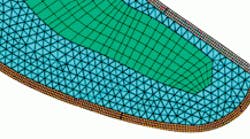Authored by: |
Anyone who’s ever typed on a mobile-device keypad has probably aimed for one letter but hit a different one on a nearby key. The result? Poor spelling, mangled messaging, or an e-mail that never should have been sent. As electronic devices become increasingly compact, “fat-finger syndrome,” as it is known in the industry, is becoming a bigger problem.
Pad computers and smart phones might have flat touchscreens that work off of pressure sensors, but keypads and keyboards that rely on the touch of a finger on a spring-loaded key are still widely used in many electronic devices such as desktop computers, laptops, some cell phones, remote controls, and appliances.
The physics behind keystrokes
The Global Production Technology Center of Samsung Co. Ltd., in Suwon, Korea, decided to tackle the problem of tinier keys and denser key layouts to make products that are both smaller and easier to use. Engineers there delved deeper into the fat-finger phenomenon by examining the physics behind keystrokes, finger pressure, and strike angle to determine what can go wrong and how to correct it. The company thinks keyboards will remain widely used for the foreseeable future, so it is important to study the ergonomics of human-device interaction. According to Samsung, using Abaqus finite-element analysis (FEA) for realistic simulations helped engineers cut mistyping errors with a prototype model of a QWERTY keypad. Systematically modifying the relevant design parameters revealed keypad configurations which led to the least number of typing errors.
To tackle fat-finger physics, engineers realized they needed two different FE models to realistically simulate the problem — one of a human fingertip and the other of a device key.
Of course, nature has already determined the human- finger configuration; Samsung needed an FEA model of it. This meant defining the separate material properties of skin, subcutaneous tissue, bone, and nail to model the overall biodynamic response of the finger. Because most small-device QWERTY keypad users type with both thumbs, the engineers started from the thumb-bone structure of a 178-cm-tall male combined with exterior skin surface data from a 3D laser scan.
Modeling the fingertip
Basing their finger-parts definitions on previous studies of human tissues, engineers queried the material database in Abaqus for the properties and element types they needed to build the FEA model. Nail and bone were modeled as linearly elastic and the skin (epidermis and dermis) was assumed to be hyperelastic and linearly viscoelastic. The finger’s deeper subcutaneous tissue was represented by a biphasic material composed of a fluid phase and a hyperelastic solid phase (essentially a spongelike porous material representing muscle, fully saturated with fluid to represent plasma).
Next, the team created a virtual keypad to simulate the interaction of fingertip and key. Pushing a physical key compresses a spring dome that completes an electronic circuit to register whatever symbol is on that key. As engineers meshed the FEA models, they built in a nonlinear spring element beneath the key to simulate the action of the spring dome.
To capture the “snap ratio” — the tactile feeling the user experiences when pushing down on a key — engineers lab tested an actual spring dome with a load cell underneath it to record pressure as the key was pushed with different degrees of force. They then used the real-world spring stiffness data to characterize the response of the nonlinear spring element in the model.
Striking a balance
To combine thumb-and-key models, engineers studied users’ real-world gripping and pushing behavior as they typed. This let the engineers pinpoint the average angle where the finger model would hit the key model. This was 16.6° from the front of the keypad and 16.4° from the side. When a user pressed the “K” key, engineers calculated the force on the two neighboring keys on either side. Engineers came up with what they called a “mistyping ratio,” defined as the force on the neighboring key buttons divided by the force on the target key.
Engineers compared the contact pressures predicted by the thumb/keyboard FEA model with test measurements obtained from an I-Scan instrument, which contained an extremely thin (0.1-mm) flexible tactile-load sensor. It verified a good correlation between models and tests.
With a working FEA model of fingers striking keys in hand, engineers next turned to optimizing the key layout. They asked the question, “Which side-by-side configuration of keys would produce the least mistyping?” The team identified several design variables: width; height; vertical angle; pitch; slope; reference face level of individual keys; and inclined angle between center points of adjacent keys.
Each of these variables needed to be applied to the keys being studied. According to the engineers, the Python script in Abaqus was useful in this because it let them automate multiple, repetitive FEA-model tasks. Engineers determined the mistyping ratio of each analysis case and then used a response-surface method to identify the optimum key position. The analysis revealed that a few of the design variables all had similar effects on mistyping. However, the reference face level and slope showed stronger, yet contradictory, tendencies. Running through 27 sets of analyses, engineers determined that the pitch of the keys on either side of the center key had to increase in order to decrease the mistyping ratio.
Using the results of their virtual finger/ keypad optimization exercise, the team was able to systematically alter the key design variables and identify a design for which the mistyping ratio improved from 37 to 7%. Again, the FEA results showed good agreement with subsequent experimental tests.
For the future, Samsung engineers see value in developing hand, arm, and whole-body models so that all aspects of users’ motion can be incorporated into device design. As human/device interfaces continue to advance, the use of FEA to model these interactions will contribute to reduced trial-and-error with the design process and improve the “emotional” quality of devices.
